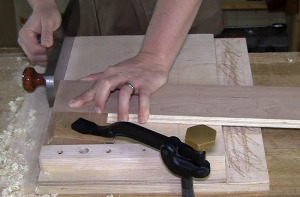Chips ‘n Tips 13: Refining Unusual Angles
 Most shooting boards will make a 90 cut and a 45 degree cut with the addition of a simple fence. Or perhaps you have a dedicated miter shooting board for 45 degree cuts. Some fancier shooting boards have adjustable fences with stops at other common angles like 22.5 degrees. But when your project throws an unusual angle at you, don’t panic…just bring a towel…er I mean keep your off cut.
Most shooting boards will make a 90 cut and a 45 degree cut with the addition of a simple fence. Or perhaps you have a dedicated miter shooting board for 45 degree cuts. Some fancier shooting boards have adjustable fences with stops at other common angles like 22.5 degrees. But when your project throws an unusual angle at you, don’t panic…just bring a towel…er I mean keep your off cut.
With the off cut you can create a custom angle shooting board. Its like really bad slight of hand magic!


 in me is seeing an opportunity…
in me is seeing an opportunity…